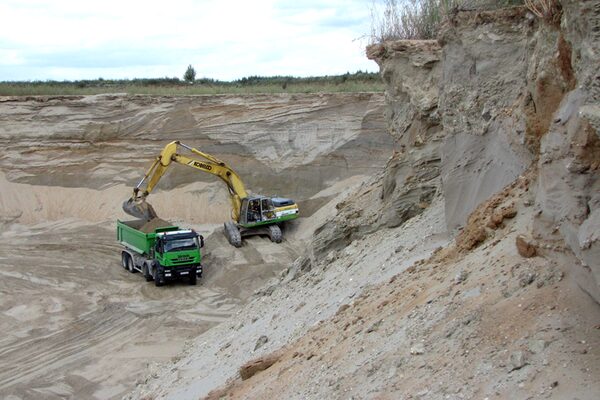Mosbach-Sande
Approximately 40 m above the present-day levels of the Rhine and Main rivers, deposits of an ice-age river system have been preserved on the "Rheingauer Feld" ridge to the east of Wiesbaden. The sands were named after the village of Biebrich-Mosbach. In the 19th century, the Mosbach sands were still extracted in small pits on both sides of Biebricher Allee, later at Waldstraße station, at Adolfshöhe and at the Nassau State Monument. This area to the north-west of today's outcrops has long since been built over.
The first fossils from the Mosbach sands were scientifically described around 170 years ago. Since then, tens of thousands of finds have revealed a rich glacial biocoenosis. It is dominated by mussels and snails (approx. 150 species) on the one hand and mammals on the other. Rarer finds include fish, amphibians and birds. The mammal fauna in particular, with more than 65 species, was and is of great importance for the large-scale organization of the Ice Age in Central Europe. This is why a number of species are named after the locality, e.g. the vole "Arvicola mosbachensis", the wild horse "Equus mosbachensis" or the wolf "Canis lupus mosbachensis". Fossils from the Mosbach sands are mainly kept in the scientific collections of larger museums in the Rhine-Main region, such as the Museum Wiesbaden, the Hessian State Museum Darmstadt, the Senckenberg Nature Museum in Frankfurt am Main and the Natural History Museum Mainz.
The fossil-bearing river deposits of the Mosbach sands can be divided into different fluvial cycles. A prehistoric Main and a prehistoric Rhine had varying contributions to the structure of the sediment stacks. Coarse gravelly-sandy as well as fine-grained, clayey sediments (referred to as coarse Mosbach and fine-grained Mosbach doline fill) lie basally in a thickness of approx. 5 m, often submerged in hollow forms (dolines) of the limestone surface. According to palaeomagnetic measurements, these sediments are to be placed in the older sections of the Ice Age (Old Pleistocene) with an age of approx. >900,000 years. A fauna poor in species and individuals ("Mosbach 1") is known from the Coarse Mosbach, in which, for example, a primeval species of steppe elephant and the Etruscan rhinoceros (Stephanorhinus etruscus) are characteristic.
The second and younger fluvial cycle of middle Pleistocene age is deposited over a significant layer gap. Its sediments are called "Gray Mosbach", in the older literature also "Main Mosbach". Coarse gravels, pebbles, sands, silts and marls with a maximum thickness of approx. 12 m make up these deposits. According to palaeomagnetic measurements, they have an absolute age of approx. <780,000 years. The fauna ("Mosbach 2"), which is rich in species and individuals, is characterized, for example, by the vole "Arvicola mosbachensis", by a small mole (Talpa minor), by the forest elephant (Elephas antiquus) and by rhinoceroses that are more advanced than the species "Stephanorhinus etruscus". Insectivores and rodents dominate among the small mammals. The large mammals include elephants (forest elephant and mammoth), even-toed ungulates (e.g. wild cattle, cervids, wild boar), odd-toed ungulates (wild horse and rhinoceros) and carnivores (e.g. wolf, bear, marten, wolverine, badger, otter, hyena, lynx, lion, panther, cheetah and sabre-toothed tiger).
The mammals and molluscs (mussels and snails) of the Mosbach 2 fauna include some species that were tied to a specific warmer or cooler climate during their lifetime. The hippopotamus, a species of Mediterranean origin, and the reindeer, an Arctic species, should be mentioned here as extremes. Animals with such contrasting climatic preferences are unimaginable together in a community. In the Mosbach sands they are united in a so-called burial community. The river sands thus contain Ice Age animals from two different climatic phases of the Ice Age, a warmer (Atlantic influenced) and a drier and somewhat cooler (continental influenced) period.
The river deposits of the Mosbach sands are not only widespread in the urban area of Wiesbaden. According to Otto Kandler (1970), they can be found west of Wiesbaden as far as the Rheingau and south or west of the Rhine in the area of Mainz and its surroundings, but this evidence still needs to be verified by means of biostratigraphic or palaeomagnetic evidence. The Mosbach sands are classified morphologically as belonging to the first and oldest terrace of the Main, the t1 terrace (Arno Semmel 1969). In the outcrops in the east of Wiesbaden, the Mosbach sands are overlain and partly eroded by two younger Main terraces (t2; t3), which are still classified as Middle Pleistocene. They do not contain any fossil content of their own. Late glacial loess lies above them.
Research into the Mosbach sands has not yet been completed. Since the early 1990s, the Hesse State Office for Monument Preservation (Palaeontological Monument Preservation) has been carrying out regular excavations and surveys. Comprehensive documentation and an associated collection of recovered finds are compiled in the so-called Mosbach Archive of the Hesse State Office for the Preservation of Monuments in Biebrich Castle.
Literature
Keller, Thomas/Radtke, Gudrun: Quaternary (Mosbach sands) and calctertiary deposits in the NE Mainz Basin, Excursion L on 14.04.2007. In: Jahresberichte und Mitteilungen des oberrheinischen geologischen Vereins, N.F. 89, 2007 [pp. 307-333].
Koenigswald, Wighart von: Remarks on the age position of the Pleistocene Mosbach Sands near Wiesbaden. In: Geologisches Jahrbuch Hessen, 115, 1987 [pp. 227-237].
Semmel, Arno: Quaternary. In: Erläuterungen zur Geol. Karte von Hessen 1:25000, Blatt Nr. 5916 Hochheim am Main, 3rd ed. 1969 [pp. 51-99].
